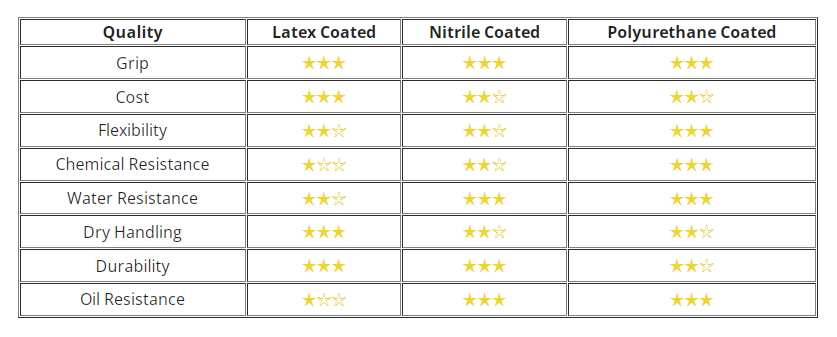Work gloves have been evolving since their emergence. New technologies in glove coating have changed the way we protect our hands, and as technology has advanced, so have the materials we use to protect our hands.
In this article, we will be looking at glove coating. There are many glove coatings to choose from, but usually you will find that the only three most common materials are latex, nitrile and polyurethane. Each coating has its pros and cons, so we hope this quick guide will give you answers to some of the questions you may have when choosing a new work glove.
Not too long ago, most gloves used latex palms. But things are a little different now, and glove manufacturers have begun to look at ways to provide protection in different materials depending on your industry. For example, nitrile works very well in oily environments, latex is best for dry work environments, and polyurethane has impressive flexibility.
Most gloves now come in polyurethane, nitrile or latex coatings, so it's important to know which is which and when to use each coating. Next we will analyze each glove coating and compare them to each other before explaining the benefits of each.

Latex coated gloves are reliable and cost-effective personal protective equipment. They are excellent in dry conditions, providing excellent grip (especially in dry conditions), and they are very durable, with a thicker coating that provides excellent protection against abrasion and other risks. The strong grip design is ideal for handling materials such as glass and sharp metal, wire, steel and other similar materials.
However, if you are working in a wet environment where you will be exposed to oils or chemicals, then we generally recommend that you do not use latex as a glove coating. It doesn't perform very well in water and the thicker design will make your flexibility suffer.
Overall, latex glove coating is great for dry tasks when a high level of grip is required.
Key Industries: Glass handling, assembly, metal handling, scaffolding, roofing.
Consider nitrile if you'll be working in environments with oil, water, or hot, sticky conditions. Foam nitrile (a more expensive version of flat nitrile) has excellent oil and water resistance. Its tacky design absorbs slippery substances and provides excellent grip, even when working on flat surfaces. Nitrile coated gloves are perfect for mechanical and engineering tasks, among others.
On the other hand, nitrile is a little more expensive than latex, unless you choose flat nitrile, but it doesn't provide as good a grip as foam nitrile. This glove coating doesn't perform as well as latex in dry conditions, but the thicker design also means it tends to be quite durable. Nitrile gloves are excellent for oily, dirty and high-abrasion risk industries.
Key Industries: Oil and gas, rigging, engineering, wet handling.
Finally, let's discuss polyurethane glove coatings. Polyurethane(PU) typically has the same oil, water, and chemical resistance as Nitrile, but it's much more dexterous and flexible when you need it most. It's also not particularly expensive when used as a type of glove coating, in part because polyurethane has excellent natural grip and doesn't require any special manufacturing processes to make it stickier.
Polyurethane performs well in wet, oily and chemical environments. It performs slightly worse than latex in dry environments. And the lighter, flexible material of this glove coating does not last as long as latex or nitrile.
Incidentally, PU is also used to make industrial coats that are ideal for mechanical, construction, and warehouse work.
Key Industries: Timber handling, mechanics, construction, warehousing.
CONCLUSION
We've put together a discussion of the three most popular glove coatings in order to see how they compare to each other. With this guide from T-Safety.com, we hope you will understand which coating is best for you. Welcome to contact and learn more.
Copyright © Hebei Sinotools Industrial Co.,Ltd. All Rights Reserved | Powered by  Sitemap
Sitemap